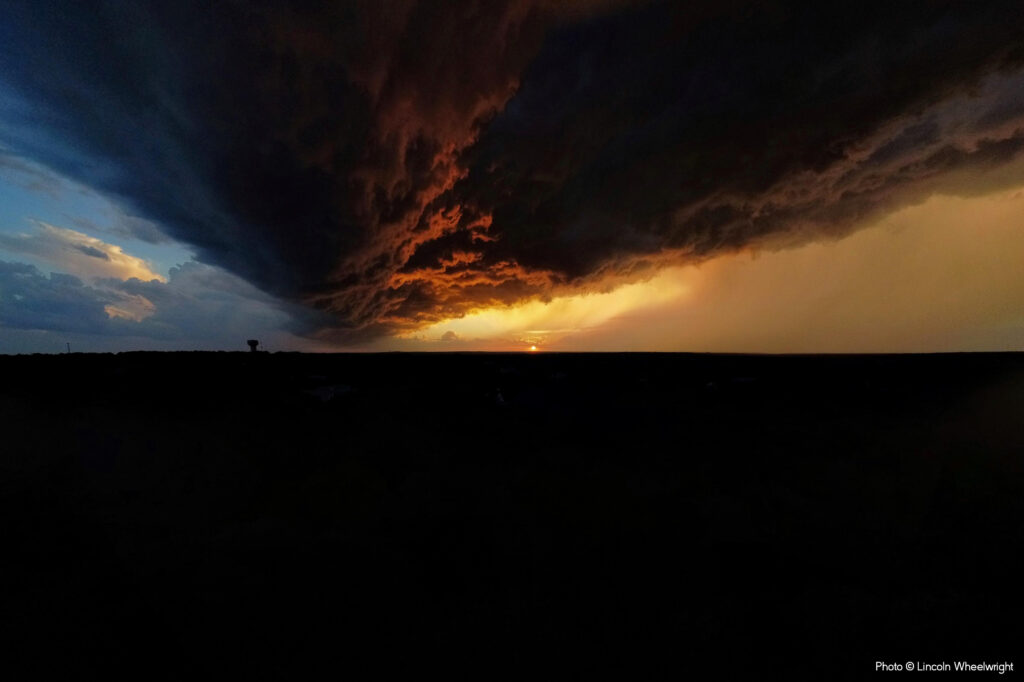The Standard Chartered Weather Photographer of the Year shows off the most awesome pictures of weather and climate from all over the world. From epic lightning storms to colourful sunsets, you’ll see it all!
The winner of Young Weather Photographer of the Year has been chosen. Take a look at the top 3 entries and find out more about their photos and the weather around them.
3rd Place: Fire and Ice by Lincoln Wheelwright.

As a thunderstorm began rolling in, young photographer Lincoln Wheelright grabbed his camera and took this picture from his house in Austin, Texas. The judging panel were particularly impressed with the split colours: the blue to the left of the cloud and the orange to the right. Lincoln explains how “the clouds were low enough that they blocked the light on the other side. This gave the effect of the fiery sunset versus the cold sky.”
Thunderstorms frequently strike late afternoon or early evening, as it tends to be the warmest and most humid time of day. Warm and moist air at the surface creates an unstable atmosphere, forming a deep cumulonimbus or thundercloud once air starts to rise. In some cases, the atmosphere becomes so unstable that the air rises without an outside trigger, but sometimes air lifted over a mountain or over a cooler, denser air mass triggers the storm.
Texas has an abundant supply of warm, moist air, thanks to the warm waters of the Gulf of Mexico to the south. The Gulf of Mexico is warming rapidly due to climate change, boosting the supply of moist air and raising the potential of intense storms in the region.
2nd Place: Saturated Earth and Sky’s Promise by Ellis Skelton.

Young photographer Ellis Skelton eloquently describes his panoramic image of Cuckmere Valley in East Sussex: “The expansive horizon of the river Cuckmere spans across the picturesque landscape and the harmonious blend of earth and sky merge capturing natural tranquillity and wonder within the landscape. Captured from above, this breath-taking panorama shows how powerful the weather can be”.
The judging panel noted how the photograph seems to contain two seasons: summer on the left and autumn on the right. The beauty of the sky contrasted with the flooding on the ground is a reminder of both the wonder and misery the sky can bring.
Sea levels are predicted to rise along the Sussex coastline, potentially by over 1 m by the end of this century. And as the Cuckmere River flows into the English Channel, those sea-level rises increase the likelihood of flooding in the Cuckmere Valley. The flood risk increases further thanks to changing river management techniques over the course of several centuries which have led to a build-up of shingle at the river mouth. There are fears that flooding could become the norm even sooner, as a Coastal Risk Screening Tool by Climate Central suggests that the annual flood level will cover most of the Cuckmere Valley by 2030.
1st Place: Rain Aria by Angelina Widmann.

Young photographer Angelina Widmann captured this stunning shot during an open-air performance of Madame Butterfly on the eastern shore of Bodensee (also known as Lake Constance) in Bregenz, Austria. Angelina noted how the “the rain made the plot even more dramatic”. This photo was taken with a telephoto lens due to the distance between Angelina and the stage. She used a short exposure to capture the falling drops, before sprinting to safety to avoid damaging her camera!
Bregenz is one of the wettest spots around Bodensee, due to its proximity to the mountains, receiving over 1600mm of rainfall per year. Perhaps this explains why the opera singers bravely continued their performances, even as the audience fled the arena in the sudden downpour! In the summer, monthly rainfall amounts can reach 200mm in Bregenz, most likely associated with summertime convection enhanced by moist air from the lake being lifted by the mountainous terrain.
As the atmosphere warms due to greenhouse gas emissions, the amount of water vapour in the air also increases. Additional water vapour means that when it rains, it pours. A change to more intense rainfall has already been observed in Europe and across the world. Although infrequent, such downpours can disrupt leisure activities, as well as transport, infrastructure and industry, so accurate forecasting of extreme rainfall will become increasingly important as our climate changes.
Add a comment




